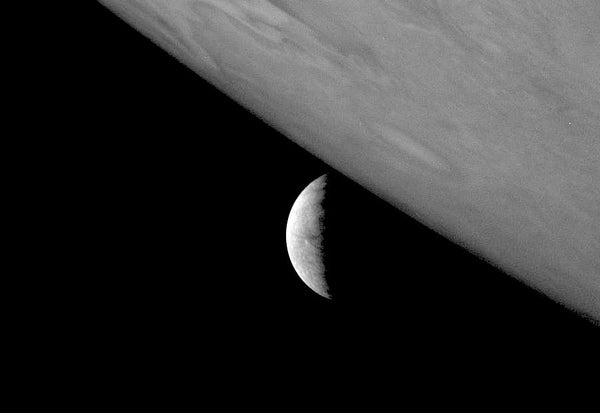This article was published in Scientific American’s former blog network and reflects the views of the author, not necessarily those of Scientific American
Jupiter’s spectacular thousand-mile-wide icy moon Europa is one of the solar system’s most tantalizing destinations. We’ve long suspected it of harboring a giant internal ocean – a dark abyss some two times the volume of all of Earth’s oceans, locked underneath a frozen shell that’s perhaps 10 to 30 kilometers thick.
We also have strong indirect evidence that Europa’s ocean is briny and not dissimilar to Earth’s ocean, pointing to an environment where a rocky, mineral-laden interior is in direct contact with liquid water. That kind of interface plays such a central role in the generation of rich and varied chemistry that it lends support to the possibility of complex organic chemistry and even the initiation of the phenomenon we call life.
But for all this promise – and a truly impressive amount of careful and compelling scientific work – the simple fact is that our up-close data on Europa is woefully limited. That can come as a bit of a shock, after all we’ve all seen the spectacular images of the moon’s surface, with its jumbled ice terrains and its massive fissure-like features and reddish blushes. In reality though, these data, from Voyager and Galileo (and even New Horizons as it was en route to Pluto) are among some of the smaller troves in our library of planetary exploration. They also represent brief moments, tiny windows of time snatched when the opportunity arose.
On supporting science journalism
If you're enjoying this article, consider supporting our award-winning journalism by subscribing. By purchasing a subscription you are helping to ensure the future of impactful stories about the discoveries and ideas shaping our world today.
In other words, we have no persistent or consistent monitoring of Europa up close, and still incomplete information about its outward features and whether or not the expected dynamics of its interior manifest themselves in real time towards its surface.
Three recent studies add some intriguing pieces to the puzzle though. First up is a reanalysis of data from the Energetic Particle Detector on the Galileo mission in 2000. This instrument was used to monitor the level of high-energy protons zipping around in Jupiter’s potent magnetosphere, yielding critical insights to the structure and behavior of this environment. But Huybrighs et al. report that during a flyby of Europa the detector actually saw a deficit of protons. The explanation that seems to fit best is that there was a water vapor plume between the spacecraft and Europa – at that very time.
In other words, without seeing it directly, Galileo may have inadvertently encountered an active venting event – where liquid water from somewhere beneath Europa’s surface was jetting to space. This lends support to claims of water plumes detected by the Hubble Space Telescope based on data taken in 2016-2017 and earlier in 2014.
A second intriguing claim is that a careful analysis of changes on Europa’s surface between the images of Voyager 1 and 2 (1979), Galileo (1995-2003), and New Horizons (2007) shows no evidence for any activity. We’d expect that some portion of any watery ejecta would in fact fall back onto Europa’s surface, changing its coloration. So, what’s going on? One option is of course that there really were no plumes during this whole period. Another option is that if the plumes erupt fairly continuously from specific areas, either jumbled zones or great chasms, they might just blend over time, with no sudden change in appearance. And a third possibility is for ‘stealth’ plumes – where the watery ejecta simply doesn’t freeze out and rain back onto the moon.
Finally, from back in 2019, researchers studied Galileo’s magnetic field data in the proximity of Europa and examined the possibility of the jovian magnetic field inducing movement in Europa’s deep, salty ocean. Their conclusion is that there could be an oceanic ‘jet stream’ close to the moon’s equator and actually moving in the opposite sense to Europa’s slow, tidally-locked, rotation.
That could be key because that amount of water moving against the outer icy shell could induce stresses that might explain some of the cracked features we see on Europa’s surface. It would also result in thinner ice towards the polar regions, which could then be prime locations for stress-induced fractures and water venting (not unlike the situation on Saturn’s moon Enceladus). This flow could also, hypothetically, play a role in transporting minerals and nutrients around the interior ocean and improve the odds for life to exist there.
All-in-all it’s been obvious for a long time that we need to get back to Europa – this time with massive data coverage. Luckily this is set to take place. First – if all goes according to current plans – with the European Space Agency’s Jupiter Icy Moons Explorer slated for launch in 2022 (arriving at Jupiter in 2029), and then with NASA’s Europa Clipper mission targeting a 2024 launch and 2030 arrival at Jupiter.
With a little more patience and luck we may be on the cusp of properly unveiling an alien world right in our backyard.
